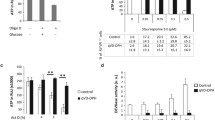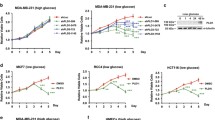Abstract
Glyceraldehyde-3-phosphate is a key intermediate in several central metabolic pathways of all organisms. Aldolase and glyceraldehyde-3-phosphate dehydrogenase are involved in the production or elimination of glyceraldehyde-3-phosphate during glycolysis or gluconeogenesis, and are differentially expressed under various physiological conditions, including cancer, hypoxia, and apoptosis. In this study, we examine the effects of glyceraldehyde-3-phosphate on cell survival and apoptosis. Overexpression of aldolase protected cells against apoptosis, and addition of glyceraldehyde-3-phosphate to cells delayed apoptosis. Additionally, delayed apoptotic phenomena were observed when glyceraldehyde-3-phosphate was added to a cell-free system, in which artificial apoptotic process was induced by adding dATP and cytochrome c. Surprisingly, glyceraldehyde-3-phosphate directly suppressed caspase-3 activity in a reversible noncompetitive mode, preventing caspase-dependent proteolysis. Based on these results, we suggest that glyceraldehyde-3-phosphate, a key molecule in several central metabolic pathways, functions as a molecule switch between cell survival and apoptosis.
Similar content being viewed by others
References
Adrain, C., Creagh, E.M., Cullen, S.P., and Martin, S.J. (2004). Caspase-dependent inactivation of proteasome function during programmed cell death in drosophila and man. J. Biol. Chem. 27, 36923–36930.
Altenberg, B., and Greulich, K.O. (2004). Genes of glycolysis are ubiquitously overexpressed in 24 cancer classes. Genomics 84, 1014–1020.
Bao, Q., and Shi, Y. (2007). Apoptosome: a platform for the activation of initiator caspases. Cell Death Differ. 14, 56–65.
Chuang, D.-M., Hough, C., and Senatorov, V.V. (2005). Glyceraldehyde-3-phosphate dehydrogenase, apoptosis, and neurodegenerative diseases. Annu. Rev. Pharmacol. Toxicol. 45, 269–290.
Fang, B., Boross, P., Tozser, J., and Weber, I.T. (2006). Structural and kinetic analysis of caspase-3 reveals role for S5 binding site in substrate recognition. J. Mol. Biol. 360, 654–666.
Garland, J.M., and Halestrap, A. (1997). Energy metabolism during apoptosis. Bcl-2 promotes survival in hematopoietic cells induced to apoptose by growth factor withdrawal by stabilizing a form of metabolic arrest. J. Biol. Chem. 272, 4680–4688.
Harlin, H., Reffey, S.B., Duckett, C.S., Lindsten, T., and Thompson, C.B. (2001). Characterization of XIAP-deficient mice. Mol. Cell. Biol. 21, 3604–3608.
Hoque, M.A., Ushiyama, H., Tomita, M., and Shimizu, K. (2005). Dynamic responses of the intracellular metabolite concentrations of the wild type and pkyA mutant Escherichia coli against pulse addition of glucose or NH3 under those limiting continuous cultures. Biochem. Eng. 26, 38–49.
Ishitani, R., Sunaga, K., Hirano, A., Saunders, P., Katsube, N., Tanaka, M., and Chuang, D.M. (1996). Evidence that glyceraldehyde-3-phosphate dehydrogenase is involved in age-induced apoptosis in mature cerebellar granule neurons in culture. J. Neurochem. 66, 928–935.
Jang, M., Park, B.C., Lee, A.Y., Na, K.S., Kang, S., Bae, K.-H., Myung, P.K., Chung, B.C., Cho, S., Lee, D.H., et al. (2007). Caspase-7 mediated cleavage of proteasome subunits during apoptosis. Biochem. Biophys. Res. Commun. 363, 388–394.
Jang, M., Park, B.C., Kang, S., Lee, D.H., Cho, S., Lee, S.C., Bae, K.-H., and Park, S.G. (2008). Mining of caspase-7 substrates using a degradomic approach. Mol. Cells 26, 152–157.
Jang, M., Park, B.C., Kang, S., Chi, S.-W., Cho, S., Chung, S.J., Lee, S.C., Bae, K.-H., and Park, S.G. (2009). Far upstream element-binding protein-1, a novel caspase substrate, acts as a cross-talker between apoptosis and the c-myc oncogene. Oncogene 28, 1529–1536.
Jiang, X., and Wang, X. (2000). Cytochrome c promotes caspase-9 activation by inducing nucleotide binding to apaf-1. J. Biol. Chem. 275, 31199–31203.
Kass, G.E., Eriksson, J.E., Weis, M., Orrenius, S., and Chow, S.C. (1996). Chromatin condensation during apoptosis requires ATP. Biochem. J. 318, 749–752.
Kilic, M., Kasperczyk, H., Fulda, S., and Debatin, K.-M. (2007). Role of hypoxia inducible factor-1 alpha in modulation of apoptosis resistance. Oncogene 26, 2027–2038.
Kumar, S. (2007). Caspase function in programmed cell death. Cell Death Differ. 14, 32–43.
Lee, A.Y., Park, B.C., Jang, M., Cho, S., Lee, D.H., Lee, S.C., Myung, P.K., and Park, S.G. (2004). Identification of caspase-3 degradome by two-dimensional gel electrophoresis and matrixassisted laser desorption/ionization-time of flight analysis. Proteomics 4, 3429–3436.
Leist, M., Single, B., Castoldi, A.F., Kuhnle, S., and Nicotera, P. (1997). Intracellular adenosine triphosphate (ATP) concentration: a switch in the decision between apoptosis and necrosis. J. Exp. Med. 185, 1481–1486.
Li, C., Xiao, Z., Zhang, X., Li, J., Li, X., Yi, H., Li, M., Zhu, G., and Liang, S. (2006). Proteome analysis of human lung squamous carcinoma. Proteomics 6, 547–558.
Lu, H., Forbes, R.A., and Verma, A. (2002). Hypoxia-inducible factor 1 activation by aerobic glycolysis implicates the Warburg effect in carcinogenesis. J. Biol. Chem. 277, 23111–23115
Majors, B.S., Betenbaugh, M.J., and Chiang, G.G. (2007). Links between metabolism and apoptosis in mammalian cells: applications for anti-apoptosis engineering. Metab. Eng. 9, 317–326.
Na, K.S., Park, B.C., Jang, M., Cho, S., Lee, D.H., Kang, S., Lee, C.-K., Bae, K.-H., and Park, S.G. (2007). Protein disulfide isomerase is cleaved by caspase-3 and -7 during apoptosis. Mol. Cells 24, 261–267.
Plas, D.R., and Thompson, C.B. (2002). Cell metabolism in the regulation of programmed cell death. Trends Endocrinol. Metab. 13, 75–78.
Priault, M., Chaudhuri, B., Clow, A., Camougrand, N., and Manon, S. (1999). Investigation of bax-induced release of cytochrome c from yeast mitochondria permeability of mitochondrial membranes, role of VDAC and ATP requirement. Eur. J. Biochem. 260, 684–691.
Robey, R.B., and Hay, N. (2006). Mitochondrial hexokinases, novel mediators of the antiapoptotic effects of growth factors and Akt. Oncogene 25, 4683–4696.
Schaefer, U., Boos, W., Takors, R., and Weuster-Botz, D. (1999). Automated sampling device for monitoring intracellular metabolite dynamics. Anal. Biochem. 270, 88–96.
Segel, I.H. (1975). Enzyme kinetics, Chapter 7 and 8, (New York: Wiley-Inter-science).
Sen, N., Hara, M., Kornberg, M.D., Cascio, M.B., Bae, B.I., Shahani, N., Thomas, B., Dawson, T.M., Dawson, V.L., Snyder, S.H., et al. (2008). Nitric oxide-induced nuclear GAPDH activates p300/CBP and mediates apoptosis. Nat. Cell Biol. 10, 866–873.
Shim, H.Y., Park, J.H., Paik, H.D., Nah, S.Y., Kim, D.S., and Han Y.S. (2007). Acacetin-induced apoptosis of human breast cancer MCF-7 cells involves caspase cascade, mitochondriamediated death signaling and SAPK/JNK1/2-c-Jun activation. Mol. Cells 24, 95–104.
Shimizu, T., Kono, N., Kiyokawa, H., Yamada, Y., Hara, N., Mineo, I., Kawachi, M., Nakajima, H., Wang, Y.L., and Tarui, S. (1998). Erythrocyte glycolysis and its marked alteration by muscular exercise in type VII glycogenosis. Blood 71, 1130–1134.
Unwin, R.D., Craven, R.A., Harnden, P., Hanrahan, S., Totty, N., Knowles, M., Eardley, I., Selby, P.J., and Banks, R.E. (2003). Proteomic changes in renal cancer and co-ordinate demonstration of both the glycolytic and mitochondrial aspects of the Warburg effect. Proteomics 3, 1620–1632.
Vander Heiden, M.G., Plas, D.R., Rathmell, J.C., Fox, C.J., Harris, M.H., and Thompson, C.B. (2001). Growth factors can influence cell growth and survival though effects on glucose metabolism. Mol. Cell. Biol. 21, 5899–5912.
Vazquez, A., de Menezes, M.A., Barabasi, A.-L., and Oltvai, Z.N. (2008). Impact of limited solvent capacity on metabolic rate, enzyme activities, and metabolite concentrations of S. cerevisiae glycolysis. PloS Comp. Biol. 4, e1000195.
Author information
Authors and Affiliations
Corresponding authors
Additional information
These authors contributed equally to this work.
About this article
Cite this article
Jang, M., Kang, H.J., Lee, S.Y. et al. Glyceraldehyde-3-phosphate, a glycolytic intermediate, plays a key role in controlling cell fate via inhibition of caspase activity. Mol Cells 28, 559–563 (2009). https://doi.org/10.1007/s10059-009-0151-7
Received:
Revised:
Accepted:
Published:
Issue Date:
DOI: https://doi.org/10.1007/s10059-009-0151-7




